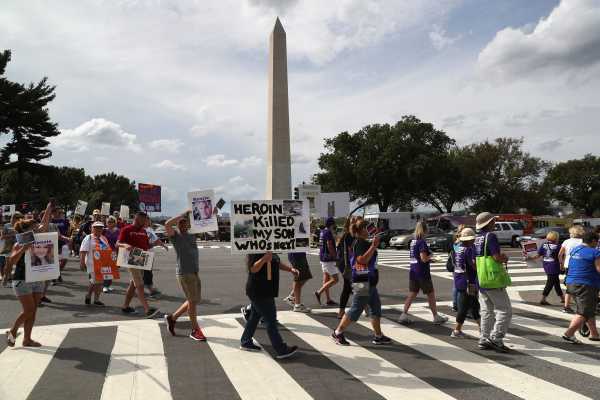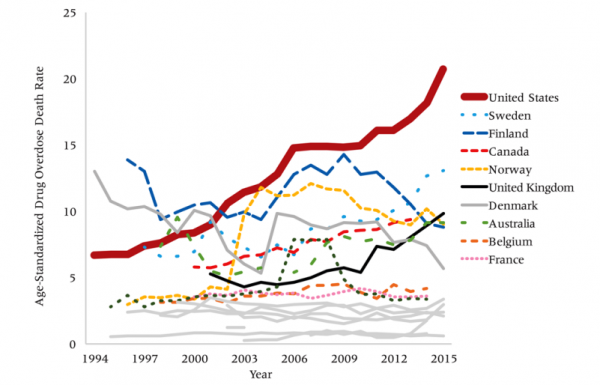
America’s opioid epidemic has driven total drug overdose deaths to record numbers — with overdose deaths hitting 70,000 in 2017, killing more people annually than guns, car crashes, or HIV/AIDS ever have in a single year in US history. But a new study confirms the level of overdose deaths isn’t just outside historical norms for the US; it’s also far beyond the norm among wealthy nations around the world.
The study, by University of Southern California researcher Jessica Ho, compared the US to 17 other wealthy nations and found that America’s level of overdose deaths has outpaced other nations for more than a decade.
Drawing on data from around the world, the study, published in Population and Development Review, found that, in the mid-1990s, the rate of drug overdose deaths in the US was largely in line with that of other developed nations. At the time, Sweden and Finland led the 18 wealthy nations in overdose deaths.
But as the opioid crisis took off in the US in the late 1990s — as pharmaceutical marketing and lobbying led doctors to prescribe far more opioid painkillers, and misuse and addiction rose — America began to outpace other countries in overdose deaths.
A second wave of drug overdoses took off in the 2000s when heroin flooded the illicit market, as drug dealers took advantage of a new population of people who used opioids but either lost access to painkillers or simply sought a better, cheaper high. Then a third wave of overdoses began, as illicit fentanyl, a synthetic opioid, started to supplant heroin in the black market — causing another spike in overdoses, since fentanyls are generally more potent than heroin or other traditionally consumed opioids.
By 2015, the US had the highest overdose death rate among any of the countries Ho studied — by far. The rate was 60 percent higher than in Finland and Sweden, which were once at the top among wealthy nations.
“On average, drug overdose mortality was 3.5 times higher in the US than in its peer countries, although this figure ranged from 1.6 to 28 times higher,” Ho wrote.
Here is what the trends look like for men, with the top 10 countries in 2003 marked by different colors and the rest uncolored:

Ho argued that America’s high overdose death rate is one reason the US falls behind other countries in overall life expectancy: “On average, life expectancy was roughly 2.6 years lower in the US than in other high-income countries in 2013 for both men and women, and drug overdose accounted for 12 percent and 8 percent of these 2.6-year gaps, respectively.”
The Centers for Disease Control and Prevention has made similar connections between the current drug overdose crisis and life expectancy, linking a rise in overdose deaths in recent years to part of the drop in US life expectancy in 2017.
One caveat to the study: It only draws on data through 2015. Since then, the opioid crisis has gotten even worse, particularly as fentanyl has continued to spread in illicit drug markets. So the US could be even worse off, comparatively, in more recent years, though Ho pointed to some evidence that Australia, Canada, and the UK seem to be on a similar trajectory.
There are real solutions to the opioid crisis
Public health and drug policy experts say there are solutions to the opioid crisis. First, America could dramatically expand access to addiction treatment — which, based on a 2016 surgeon general report, remains inaccessible to the bulk of people who need it. That should entail dramatically boosting access to medications like methadone and buprenorphine, which are considered the gold standard of treatment for opioid addiction and reduce the mortality rate among opioid addiction patients by half or more.
When France relaxed restrictions on doctors prescribing buprenorphine in response to its own opioid crisis in 1995, the number of people in treatment rose and overdose deaths fell by 79 percent over the following four years.
Beyond treatment, prescribers could also cut back on excess opioid painkiller prescriptions — to prevent more people from misusing the drugs — while still ensuring patients who truly need them get access. Harm reduction approaches, such as needle exchanges and more distribution of the opioid overdose antidote naloxone, would also help.
Several of the states that took these kinds of steps, based on state and federal data, saw overdose deaths drop or level off in 2017.
Vermont saw its overdose death rate drop by around 6 percent in 2017 with the continued expansion of a hub-and-spoke system that integrates addiction treatment into the rest of health care. Rhode Island also saw a roughly 2 percent drop as it implemented, among other changes, better access to opioid addiction medications in its prisons and jails. And Massachusetts saw a roughly 3 percent drop, along with a public health campaign that has emphasized more addiction treatment, including in emergency rooms, and fewer painkiller prescriptions.
These aren’t huge decreases. But they’re significant because they’re in states in New England — which has been among the regions hardest hit by the opioid crisis and has seen overdose deaths consistently increase in recent years. Public health interventions can also require time to take root, as more and more of the public learns the risks of addiction and that treatment is really available now.
A consistent problem for many states has been a lack of federal resources. Congress has increased funding for opioid addiction treatment here and there in recent years, but the money allocated so far falls very short of the tens of billions of dollars that experts say is necessary to fully and quickly confront the opioid epidemic. And despite lavish promises, President Donald Trump has done little to change that.
So America continues leading other wealthy nations in overdose deaths.
For more on the solutions to the opioid epidemic, read Vox’s explainer.
Sourse: vox.com






